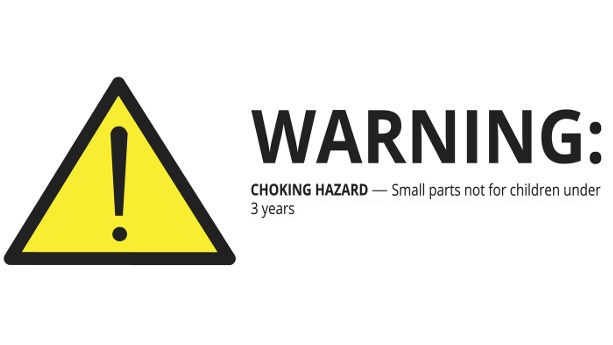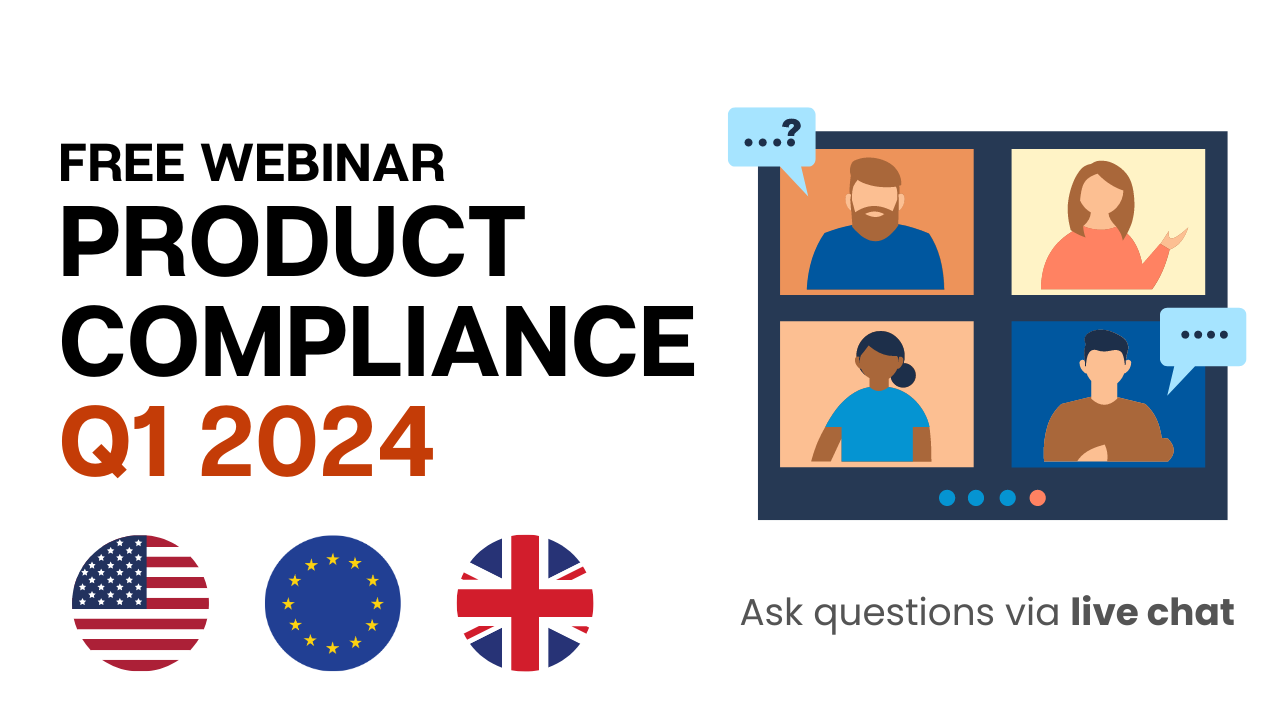
Warning labeling requirements in the United States cover everything from suffocation hazards and small parts to fall and strangulation risks. This guide serves as a brief instruction to warning labeling requirements for children’s products in the United States.
Further, we provide warning label examples that are published on official websites such as Federalregister.gov. However, keep in mind that these examples might already be outdated.

FREE CONSULTATION CALL (US, EU & UK)
The CPSIA, and related ASTM standards, cover warning label requirements for children’s products, including the content, layout designs, and placement. In short, warning labeling can apply to most children’s products – and also depend on the age group and other factors.
Here is a (non-exhaustive) list of children’s products that require warning labels:
Also, some children’s products may be required to include more than one kind of hazard warning label, depending on the potential risk of the product. For example, a soft infant carrier is required to have both a fall hazard and a suffocation hazard warning label.

The CPSIA requires that children’s products containing balls, small balls, latex balloons, marbles, or small parts, should bear a choking hazard warning label. This is to prevent the risk of young children choking due to the ingestion of either small products, or products that contain removable or detachable small parts.
Here we list the definitions provided by CPSIA:
Small part: Object that fits completely into a 2.25 (57.15 mm) inches long and 1.25 (31.75 mm) inches wide cylinder, which is close to the size of the fully expanded throat of a child under three years old.
Small ball: a ball that is able to pass in any orientation, entirely through a circular hole with a diameter of 1.75 inches (44.45 mm) in a rigid template that is 0.25 inches (6.35 mm) thick.
Marble: a ball that is made of materials such as glass, agate, marble, or plastic. Marble balls are found in various children’s games, generally as a playing piece or marker.
Latex balloon: a latex bag that is designed to be inflated by air or gas. This term does not include latex bags that are used in rafts, water wings, swim rings, or other aquatic activities.
Further, the prohibited age range shall be suggested in the choking warning text as well, such as “Not for under 3 years” or “Not for under 8 years”. The age range is determined by the most restrictive age range for all required cautionary statements for that product.
Note that small parts are banned in products that are designed for children under 3 years of age, such as baby pacifiers.
Choking hazard warning labels are mandatory for children’s products that contain small parts (e.g. small accessories, detachable parts) and that are designed for children from 3 to 6 years of age, including:
For some specific products, such as balloons, the warning might concern kids up to 8 years old.
16 CFR § 1500.20 – Labeling requirement for advertising toys and games provides specific examples of choking hazard warning labels
“WARNING: CHOKING HAZARD – Small parts. Not for children under 3 yrs.”
“WARNING: CHOKING HAZARD – Children under 8 yrs. can choke or suffocate on uninflated or broken balloons. Adult supervision required.
Keep uninflated balloons from children. Discard broken balloons at once.”
Suffocation warning labels apply to some children’s products including bassinets, and baby carriers under the CPSIA. The suffocation warning label is to remind caregivers that these products could pose suffocation hazards, such as when infants are caught in between the gaps of the sleeping pad and the bars or when the infant’s face presses against the products.
Here some examples of standards that require suffocation warning labels:
a. ASTM F2194 – Standard Consumer Safety Specification for Bassinets and Cradles
b. ASTM F2236 – Standard Consumer Safety Specification for Soft Infant and Toddler Carriers
c. ASTM F2388 – Safety Specification for Baby Changing Products for Domestic Use
These products that are required to have suffocation warning on the label:
The warning content might differ among products. Importers and manufacturers should describe in what ways the product would cause suffocation hazards to children.
Fall hazard warning labels are mandatory for certain children’s products. The goal is to remind users of the fall risks of children when using these products. For instance, infants could fall from the opening leg of the baby carriers, or when the caregivers place infants on the changing tables.
The following safety standards require fall warning labels:
a. ASTM F2388 – Safety Specification for Baby Changing Products for Domestic Use
b. ASTM F2236 – Standard Consumer Safety Specification for Soft Infant and Toddler Carriers
c. ASTM F2906 – Safety Specification for Bedside Sleepers
These products that are required to have fall hazard warning on the label:
Sharp edges or points are prohibited in many children’s products in the US. This rule applies to children’s furniture such as bed rails, portable hook-on chairs, and frame child carriers.
However, the CPSC allows some toys to have functional sharp edges or points that are necessary to the structure or design of the products. In this case, it requires that such toys that are used by children between the ages of 4 and 8 years, shall carry a sharp edge warning label.
The following safety standard is relevant to products that contain sharp edges:
a. ASTM F963 – Safety Specification for Toy Safety
The entanglement and strangulation warning applies to some children’s products that could lead to serious injury or death caused by strangulation. The CPSC requires products like carriages, strollers, and cribs to bear such warnings since there have been stroller strangulation incidents. This has mostly happened when the infants’ bodies pass through the opening between the hand rest bar but his/her head and neck were entrapped.
The following safety standards require strangulation warning label on children’s products:
a. ASTM F833 – Safety Performance Specification for Carriages and Strollers
b. ASTM F2933 – Safety Specification for Crib Mattresses
c. ASTM F406 – Safety Specification for Non-Full-Size Baby Cribs/Play Yards
These are examples of children’s products that might pose entanglement or strangulation hazards to children:
Children’s products containing coin cell batteries or magnetic parts are required by the CPSC to bear swallowing warnings on product labels. This is to avoid hazards such as internal chemical burns caused by swallowing batteries or the intestinal blockage or penetration caused by swallowing the magnets.
The following safety standards require swallowing warning labels:
a. ASTM F963 – Safety Specification for Toy Safety
b. ASTM F2923 – Product Safety for Children’s Jewelry
Adult supervision warning labels are required for some children’s toys or products that might cause serious injuries to children when used under no supervision of adults. These injuries include falling off the stairs, choking, swallowing, and drowning.
The following safety standard requires adult supervision warning label:
a. ASTM F977-18 Safety Specification for Infant Walkers
Many ASTM standards for children’s products require warning texts to be printed both on the product and packaging. However, for smaller-sized products, it may not be possible to print the warning label on the product – in which case the packaging may be the only option.
For example, placing a warning label on a baby’s crib is easier than on a small piece of magnet. In this case, the warning label might not be required on the product. The warning statement must also be added to advertising material such as catalogs, websites, and more.
Quote from 16 CFR Part 1500 Labeling Requirement for Toy and Game Advertisements
“Section 105 of the CPSIA amends section 24 of the FHSA to require that, when a product’s packaging requires a cautionary statement, advertising for the product that provides a direct means for purchase or order of the product (including catalogues, other printed materials, and Internet Web sites) must bear the same cautionary statement.”
First of all, you need to assess all applicable warning labels for your product and the packaging. This guide only serves as an introduction, and the examples may already be outdated by the time of publication. As such, getting help from a consultant or other service provider is the first step.
Second, create ready-to-print label files (usually .ai or .eps) and send the files to your supplier. Never assume that your overseas manufacturer is even aware of warning labeling requirements in the United States. In fact, most of them are not.


Disclaimer: The Site cannot and does not contain legal advice. The legal information is provided for general informational and educational purposes only and is not a substitute for professional advice. Accordingly, before taking any actions based upon such information, we encourage you to consult with the appropriate professionals. We do not provide any kind of legal advice. THE USE OR RELIANCE OF ANY INFORMATION CONTAINED ON THE SITE IS SOLELY AT YOUR OWN RISK.
Sources: Our articles are written in part based on publicly available information, and our own practical experience relating to product compliance. These are some of the primary sources we use:
Mo Chuiyan has an MA degree in Islamic Studies from the Hebrew University of Jerusalem. She has previously worked as a marketing developer for Middle Eastern countries in an E-commerce company. She has also worked as a merchandiser in the garment industry, where she gained expertise in material sourcing and production management. See Full Bio.
Heidi July 11, 2024 at 8:49 am Where multiple warnings are applicable to a product, are you allowed to run them together in one ‘Warning Box’?
Mark Henderson March 3, 2024 at 10:27 pm I would like to have a conversation about my product. We are launching a sponge type product ( not a toy) for use in Hot tubs by adults that absorbs the oil and lotions in the water. These sponges are in the shape of fish. See an opportunity to move this product into the toy market as a plush toy. I need help with necessary compliance requirements.
Please let me know if we can talk.
Regards,
Mark Henderson
Kate February 20, 2024 at 12:26 am Hello,
Can you confirm if ‘Small Parts Choking Hazard Warning’ are legally required on products that are not classified as children’s products under CPSIA? For example, if a paper Christmas Gift Bag includes a single decorative non-functioning 15mm bell or a single decorative 15mm rhinestone, is a small parts warning required on the product packaging? After lots of research and reading, I am unable to find any specific direction, statement, or verification that small parts warnings are not required for non-children’s products. Thank you.
Eliana September 30, 2023 at 3:16 am Hi Gena you’re right. Warning labels must be on immediate packaging.